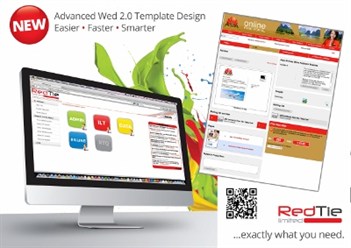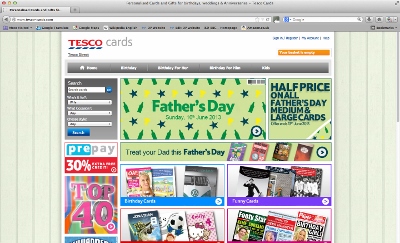Tesco’s cards ordering site, www.tesco-cards.com, is based on Catfish.
Adopting web to print may need you to rethink your whole approach to sales. Simon Eccles talks to two developers with definite views on the methods to use.
We are now seeing the web to print market starting to reach maturity. For many printers the question is no longer whether they need an online e-commerce site, but what to do with it once they have got one. In particular, how does it fit in alongside traditional sales techniques: does it merit an entirely different approach or is it just another weapon in the sales staff’s armoury?
Digital Printer asked a couple of the most experienced web to print developers for their views, and about how they see successful customers implementing the systems into their sales operations.
Tim Cox is managing director of Vpress (www.vpress.co.uk), developer of the Coreprint web to print system that was introduced 12 years ago, with frequent updates since. There are some 1500 users worldwide. Today it’s a Cloud-based system available in either standard form, where Vpress helps to set up templates and manage the system, or Pro, for customers with the in-house IT expertise to do it themselves. At North Print & Pack in May it announced a new alliance with Konica Minolta, which will offer Coreprint as part of its software suite.
Mr Cox has been at Vpress for just over a year, but has a long track record in web to print going back to his time at ROI, UK distributor for the pioneering Pageflex web to print, document generation and marketing campaign management systems. After years of seeing how online print selling has developed, he has definite ideas on the right and wrong ways to do it.
Web to print does not sell itself, he stresses. ‘There’s always a need for sales people, but they need to change what they do. If you are a traditional printing company with a traditional approach to clients, then you should perhaps educate bosses and sales teams that the world is shifting.
‘They’ve got to get their heads around marketing and how that is changing too; look at YouTube and forums, and see what customers are doing. Too many people do what they have always done.’
Printers need to re-market themselves and think about how their brand is perceived, he believes. Web to print is only a part of the message. ‘They tend to think they understand how their customers businesses work, while customers think they know what a printer can do. But often they are poles apart. Sales people need to be more consultative and do business development with customers, not just sell print. Customers may not know about new finishing techniques, or automated procurement online. Printers need to educate customers about innovations they can use.’
Sales teams could usefully learn from each other and from other parts of their companies, he feels: ‘I’d always suggest that sales teams get together and discuss opportunities, what the customers are up to, what the competition is doing etc. I encourage customers to send a technical person out with the sales people, who can look for new opportunities at the clients, and explain new ideas. I also suggest that the sales people spend a day in the press room to see what’s being done and ask what the issues are.’

Tim Cox, VPress.
RedTie
Kevin Tyler is head of business growth at RedTie (www.red-tie.co.uk). Its main products are RedTie Template, which allows the creation of unlimited numbers of branded online storefronts where customers can create jobs using predefined templates; and RedTie Quotation, an instant online quotation tool with a range of pricing calculators.
The company has always stressed market support and education to go along with its products.
‘There is no doubt in my mind that web to print is just about the most effective sales tool for the modern print provider, but the issue is clearly in the way it is being sold,’ said Mr Tyler. ‘Web to print in itself is not the key to success. The print provider has to bring more to the table than just online ordering.
‘They must be focused on a “what can I solve” approach for each client. Simply trotting out a load of generic benefits like 24/7 access, brand control, more targeted marketing, less admin, time savings etc, is simply not going to win you the business in most cases.
‘We think it is generally true that the modern print buyer does not want to talk to a print salesperson,’ he explained. ‘They want to talk to someone who can solve problems and offer them ROI. This means the traditional sales people must change their approach to be successful and they must sell the difference.
‘You will find that most buyers of print already expect, and probably take for granted, a competitive print price, quality, flexibility, high levels of service, environmental responsibility, ISO quality standards, etc. So the print salesperson must be offering something new and genuinely compelling; something they do not take for granted. This is how they are going to differentiate themselves from competitors and start selling the difference.
‘Changing your approach to begin to sell print solutions rather than just print products requires a thorough understanding of the potential of web to print. This is why I am spending a good deal of my time these days taking our seminars and training events out on the road to share case studies and success stories and offer real practical help and advice on selling in the modern economy.’
The next one of these free seminars will be at Magnolia Park Golf & Country Club, Bucks, on 27 June. Contact www.red-tie.co.uk for more details.

Catfish
The past year has seen a new entry into the choice of systems sold in the UK. Infigo Systems Ltd (ISL), which originally sold the Infigo web to print system, has replaced it with a new product called Catfish.
This uses new code developed by ISL, said ISL managing director Douglas Gibson. ‘It’s a lot more flexible, more focused, the configurability is much higher and the look and feel is more in keeping with modern websites. It’s a better user experience, much slicker, easier to administer and manage. It’s the only one that offers a proper B2C e-commerce facility. For instance we handle Tesco’s cards ordering site, www.tesco-cards.com.’
Catfish is hosted by ISL and uses HTML5 for its client facing web browser activities. This gives it considerable cross-platform and cross-browser flexibility without the need to download Java apps or the like. It also allows access from Apple iPads, which will not work with the main alternative technology, Flash.
There are more than 50 users, said Mr Gibson: ‘About half are former Infigo users, half are new. We’re getting three or four new clients per month, which is double what we got previously.
‘The new API lets us call into different systems, such as MIS, pulling data in from other sites. For instance we have a music site that pulls in XML song sheets to make personalised music books. We’re now working on a custom book module that will be unique. This will allow books on demand, photo books and self-published books, without customers needing to download software. We have full support for fonts, allowing effects similar to DirectSmile image personalisation. We’re also going after Taopix in the photo books arena at the end of this year.’
There are three charging levels for Catfish: standard, premium and advanced, depending on the number of storefront you want to run. There’s an upfront cost to set it up and then a monthly fee.
Chili Publisher
Chili Publisher is an online document composition engine that can be built into web to print storefronts. It offers sophisticated and extensive job editing features, with 3D animated previews, through standard web browsers. At present it uses the Flash platform, which allows a lot of user interactivity without having to download Java apps or the like.
However, the next upgrade, Chili Publisher 4, due in September, will switch from Flash to HTML5. This runs directly in modern web browsers (Flash is an Adobe-supplied plug-in) and also opens up the possibility of accessing Chili based sites via Apple iPads in future.
The developer of Chili Publisher is called Chili Publish, which can be slightly confusing. Based in Belgium, the company has already produced three major upgrades since the initial launch in 2010.
The software engine is mainly licensed to third party web to print developers, but can also be supplied directly to printers that wish to integrate it into their home-grown systems. However, the price of £35,000 means that end user integration will probably be confined to larger printers. When supplied by a web to print developer the costs can be spread out more.
Some integrators have announced that they are using it, notably Agfa in its Apogee Storefront, Esko in its WebCenter web-based packaging platform, and Tharstern in its e4print Pro. GamSys, the mainly French language ERP/MIS developer that’s just been bought by EFI, also licenses Chili Publisher.
The UK distributor is Workflowz, whose managing director Alan Dixon gave us a run through of the key features. It’s an alternative to Adobe’s InDesign server, which is often used to add browser based document editing to print ordering systems. Templates are set up in the standalone InDesign and are then converted into the Chili format for delivery to browsers.





